GALE
-
Official Full Name
UDP-galactose-4-epimerase -
Overview
This gene encodes UDP-galactose-4-epimerase which catalyzes two distinct but analogous reactions: the epimerization of UDP-glucose to UDP-galactose, and the epimerization of UDP-N-acetylglucosamine to UDP-N-acetylgalactosamine. The bifunctional nature of the enzyme has the important metabolic consequence that mutant cells (or individuals) are dependent not only on exogenous galactose, but also on exogenous N-acetylgalactosamine as a necessary precursor for the synthesis of glycoproteins and glycolipids. Mutations in this gene result in epimerase-deficiency galactosemia, also referred to as galactosemia type 3, a disease characterized by liver damage, early-onset cataracts, deafness and mental retardation, with symptoms ranging from mild (peripheral form) to severe (generalized form). Multiple alternatively spliced transcripts encoding the same protein have been identified. -
Synonyms
GALE;UDP-galactose-4-epimerase;galactose 4 epimerase, UDP;UDP-glucose 4-epimerase;SDR1E1;short chain dehydrogenase/reductase family 1E;member 1;UDP glucose 4 epimerase;FLJ95174;FLJ97302;Galactose 4 epimerase UDP;Galactowaldenase;GALE_HUMAN;OTTHUMP00000002991;OTTHUMP00000002994;OTTHUMP00000037931;OTTHUMP00000044857;short chain dehydrogenase/reductase family 1E member 1;UDP galactose 4 epimerase;UDP-galactose 4-epimerase;UDP galactose-4-epimerase;galactose-4-epimerase, UDP-;short chain dehydrogenase/reductase family 1E, member 1
Recombinant Proteins
- Bacillus subtilis
- Human
- Rhesus macaque
- Zebrafish
- Mouse
- E.Coli/Yeast
- E.coli
- Mammalian Cells
- HEK293
- Wheat Germ
- In Vitro Cell Free System
- His
- Non
- Avi
- Fc
- DDK
- Myc
- SUMO
- GST
Background
What is GALE Protein?
GALE protein, or UDP-galactose 4'-epimerase, is an enzyme that plays a key role in sugar metabolism. It helps flip UDP-galactose to UDP-glucose and back, which is important for energy and making vital biomolecules. When GALE doesn’t function properly, it can cause galactosemia, where galactose isn’t processed right, leading to its buildup and health problems. Studying GALE matters because it sheds light on how our bodies handle sugars and helps in diagnosing and possibly treating metabolic disorders tied to sugar processing.What is the Function of GALE Protein?
GALE protein's main job is to flip sugars around in our cells. It swaps UDP-galactose to UDP-glucose and the other way, which is crucial for various cellular functions, like energy production and building structural molecules. This swapping process is part of the larger Leloir pathway, which is how our bodies manage galactose from food. When GALE doesn't work right, it disrupts this balance, leading to metabolic issues like galactosemia. So, GALE is vital for keeping our sugar metabolism in check and ensuring cells have the right ingredients to function smoothly. Understanding this protein helps us grasp how sugar imbalances can affect health.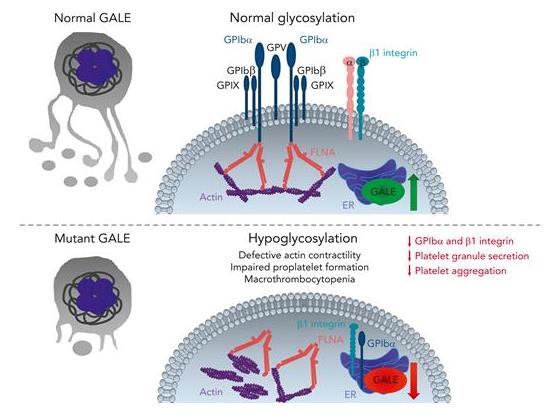
Fig1. GALE-mediated glycosylation in megakaryocytes and platelets. (Attila Braun, 2023)
GALE Related Signaling Pathway
GALE protein is crucial in the Leloir pathway, which helps our bodies handle galactose, a sugar from food. It turns UDP-galactose into UDP-glucose, balancing these sugars for energy and building vital structures in cells. If GALE doesn't work right, this balance is off, leading to issues like galactosemia. Grasping GALE's part in this pathway is key to understanding sugar processing problems and finding treatment approaches for related metabolic disorders.GALE Related Diseases
GALE-related diseases mostly involve galactosemia, a genetic disorder where the body struggles to break down galactose from food. When GALE isn't functioning right, galactose and its by-products accumulate, leading to health issues like liver problems, developmental delays, and cataracts. These symptoms are especially concerning for newborns and young children as they start ingesting sugars. Early detection and managing the diet by avoiding high-galactose foods are key to preventing complications. Understanding GALE's role is vital for creating treatments and effectively managing the disease.Bioapplications of GALE
GALE offers some cool bioapplications due to its role in sugar metabolism. Learning about GALE helps us understand and address metabolic disorders like galactosemia, where breaking down certain sugars is an issue. By studying GALE, researchers aim to find better ways to manage these problems and maybe even correct them. It also helps in developing diagnostic tools for early detection of metabolic conditions. Plus, understanding GALE can inspire new ideas in metabolic engineering, like improving how we produce biofuels or drugs by enhancing sugar processing in industrial settings.Case Study
Case Study 1: Marín-Quílez A. et al. Blood. 2023
Glycosylation is crucial for making megakaryocytes and platelets. The enzyme UDP-galactose-4-epimerase, coded by GALE, is key in this process. Researchers studied three patients from two families with severe lifelong thrombocytopenia and other health issues. Whole-exome sequencing found four GALE variants, three new. These patients had abnormal, giant gray platelets with poor function, and low enzyme activity was found. Their platelets had less GALE protein, reduced glycosylation, and more apoptosis. Lab tests showed their megakaryocytes formed fewer proplatelets due to faulty glycosylation. Protein and structure issues were also evident, affecting their blood cells' function.-
 Fig1. Western blotting from platelet lysates of patients from both pedigrees, unaffected relatives, and controls.
Fig1. Western blotting from platelet lysates of patients from both pedigrees, unaffected relatives, and controls. -
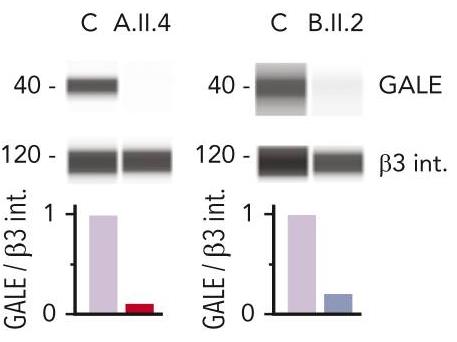 Fig2. Immunoblotting of MK lysates.
Fig2. Immunoblotting of MK lysates.
Case Study 2: McCorvie TJ. et al. Biochim Biophys Acta. 2012
UDP-galactose 4'-epimerase deficiency leads to type III galactosemia. In mild cases, variants p.K161N-hGALE and p.D175N-hGALE are involved. p.K161N-hGALE has low enzyme activity, increased stability, and poor cofactor binding, struggling to help yeast with galactose issues unless with UDP-N-acetylgalactosamine. It's more stable than the normal protein but alters with specific molecules. p.D175N-hGALE helps yeast more effectively and gains stability with substrates. p.K161N likely disrupts a key interaction with cofactors, while p.D175N might affect a stabilizing salt bridge, showing cofactor binding's critical role in disease.-
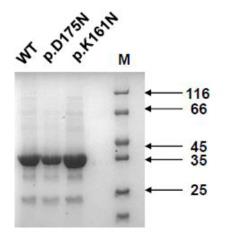 Fig3. Purified recombinant hGALE variants from E. coli.
Fig3. Purified recombinant hGALE variants from E. coli. -
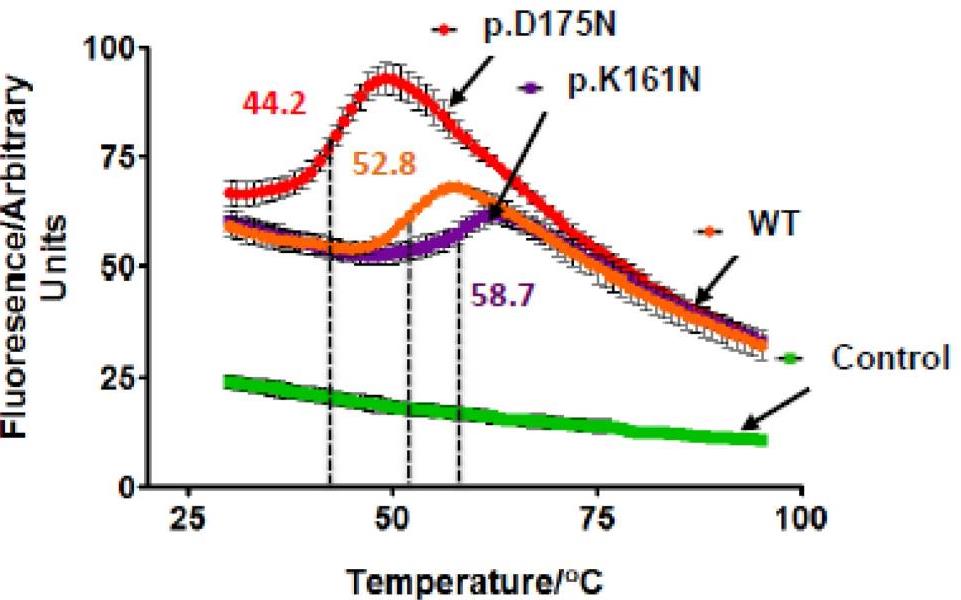 Fig4. Melting profiles and melting temperatures of WT, p.K161N-hGALE, and p.D175N-hGALE in the absence of substrates and cofactors.
Fig4. Melting profiles and melting temperatures of WT, p.K161N-hGALE, and p.D175N-hGALE in the absence of substrates and cofactors.
Quality Guarantee
High Purity
-
.jpg) Fig1. SDS-PAGE (GALE-2398H)
Fig1. SDS-PAGE (GALE-2398H) -
.jpg) Fig2. SDS-PAGE (GALE-2413H)
Fig2. SDS-PAGE (GALE-2413H)
Involved Pathway
GALE involved in several pathways and played different roles in them. We selected most pathways GALE participated on our site, such as Galactose metabolism,Amino sugar and nucleotide sugar metabolism,Metabolic pathways, which may be useful for your reference. Also, other proteins which involved in the same pathway with GALE were listed below. Creative BioMart supplied nearly all the proteins listed, you can search them on our site.
| Pathway Name | Pathway Related Protein |
|---|---|
| Amino sugar and nucleotide sugar metabolism | MPI,HK1,UGDH,PMM1,NAGK,GMPPAB,CYB5RL,CHIA.2,CYB5R3,UGP2A |
| Galactose metabolism | G6PC3,AKR1B8,AKR1B7,G6PCA.2,HK2,UGP2A,PFKMA,PGM1,GALK1,PFKP |
| Metabolic pathways | ACSM2B,GNS,NADSYN1,NDUFS8B,AK2,AGXT2L2,DEGS1,HEXA,PCYT1AA,POLR3F |
-
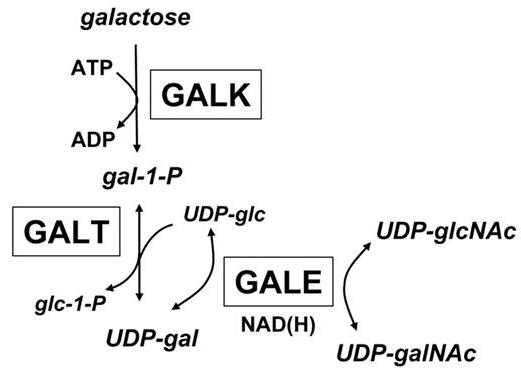 Fig1. The Leloir pathway of galactose metabolism. (Rebecca D Sanders, 2010)
Fig1. The Leloir pathway of galactose metabolism. (Rebecca D Sanders, 2010)
Protein Function
GALE has several biochemical functions, for example, UDP-N-acetylglucosamine 4-epimerase activity,UDP-glucose 4-epimerase activity,protein homodimerization activity. Some of the functions are cooperated with other proteins, some of the functions could acted by GALE itself. We selected most functions GALE had, and list some proteins which have the same functions with GALE. You can find most of the proteins on our site.
| Function | Related Protein |
|---|---|
| protein homodimerization activity | PARK7,VOX,DMRT2A,APOE,SEPHS1,USF2,GOT2,BST2,CADM1,PLEK |
Interacting Protein
GALE has direct interactions with proteins and molecules. Those interactions were detected by several methods such as yeast two hybrid, co-IP, pull-down and so on. We selected proteins and molecules interacted with GALE here. Most of them are supplied by our site. Hope this information will be useful for your research of GALE.
q8czv1_yerpe;FN1
Resources
Related Services
Related Products
References
- Hong, X; Lejeune, MA; et al. Stochastic network design for disaster preparedness. IIE TRANSACTIONS 47:329-357(2015).
- Goudge, TA; Mustard, JF; et al. Integrating CRISM and TES hyperspectral data to characterize a halloysite-bearing deposit in Kashira crater, Mars. ICARUS 250:165-187(2015).


